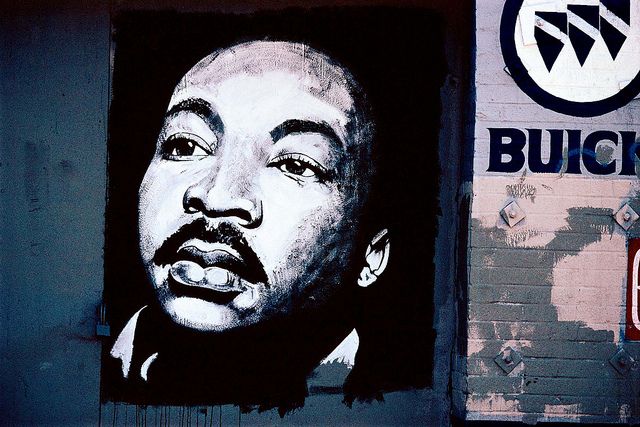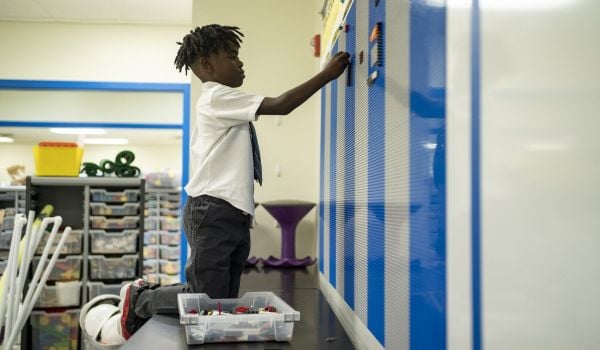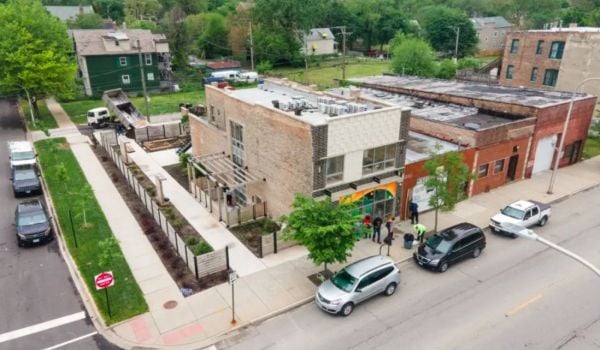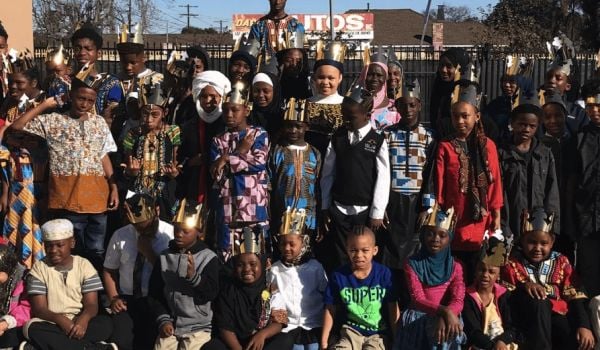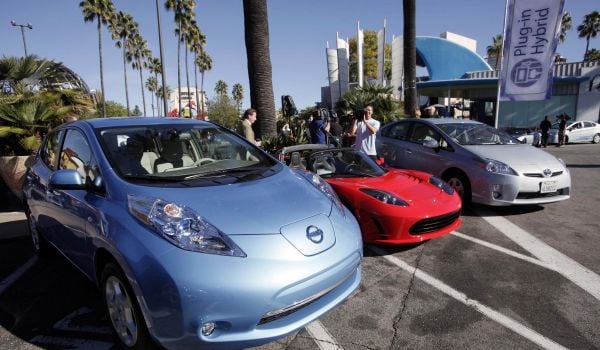Traveling along the streets and alleys of inner-city neighborhoods, I find commercial signs, graffiti, folk altars and murals that announce why residents remember their dead, who is worthy of their admiration, to whom they pray and the achievements of their ancestors. These artifacts, painted or assembled by neighborhood people, represent a shared history of beliefs. They give us glimpses into what residents of America’s poor, minority communities hold as meaningful.
Drawing from this tradition since the 1970s, I have created a photo archive of urban graphic art devoted to Martin Luther King, Jr. that I encountered in New York, Los Angeles, Chicago, Detroit and other cities.
I did not set out to form a collection. Instead, I found an image and photographed it. Then I found another, eventually accumulating a unique, well-defined group of images. These portraits appear on the walls of liquor stores, barbershops, small neighborhood markets and fast food restaurants. Often the owners give artists a free hand with the commission. I exclude less spontaneous representations of King that are popular in public schools, hospitals and community organizations and that were made under the scrutiny of the principal or a public official. Repeatedly revisiting neighborhoods to photograph them, I look for signs and images that endure, their survival giving the best testimony of their acceptance.
In talking with artists and storekeepers, I learned of various ways in which these portraits function. They serve many purposes, from helping sell merchandise, to making businesses more secure against vandalism and crime, to encouraging a sense of pride in poor communities. For example, after the 1992 riots in South Los Angeles, many Latino shopkeepers painted King’s portrait on the façades of their businesses in the hope of deterring rioters. Later, when Latinos became the majority, King’s image was often replaced by that of Christ, the Virgin of Guadalupe and other symbols of Mexican or Central American identity.

47th Street at Normandie Avenue, Los Angeles, 1997. Credit: Camilo Vergara
On the streets, King is represented in many ways — as a statesman, visionary, hero or martyr. Often, his most famous pronouncement, “I have a dream,” accompanies his image. Some paintings depict him as proud and thoughtful, resting head on hand, while in others he looks friendly and compassionate, arms outstretched.
The sign painters and amateur artists who create these portraits use iconic photographs of King to model their subject. However, they often fall short of producing good likenesses. It is not uncommon for him to turn out looking Latino, Native American or Asian. In Los Angeles in 2013, I had to stop at El Taco Mexicano to ask a cook if the portrait of someone looking like a brown-skinned campesino, depicted between images of Cesar Chavez and John F. Kennedy, was really of King.
In black neighborhoods, though, portraits of King rarely include Latino figures. Rather, he is often accompanied by such icons such as Malcolm X, embodying righteous anger, or by other black leaders such as Nelson Mandela, Harriet Tubman and Rosa Parks. And while King remains a popular icon, portraits of Malcolm X and Nelson Mandela are fading out as few new ones replace them. Since 2009, he has been painted with President Obama. A local resident explained the pairing by saying, “Rosa Parks sat so Martin Luther King could walk. Martin Luther King walked so Obama could run. Obama ran so we all can fly.” In group portraits, King takes center stage, usually the larger or largest figure.
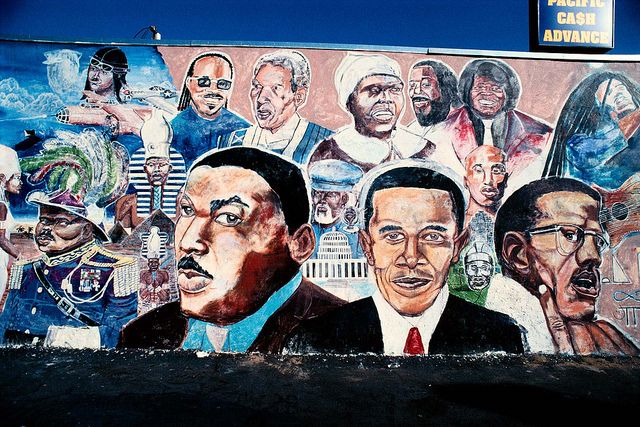
Western Avenue, Los Angeles. Mural by Shyaan Khufu. Credit: Camilo Vergara
In Latino neighborhoods, figures such as Pancho Villa, Benito Juarez and Cesar Chavez appear in company with King. And once, among the ruins of what once was the Detroit’s Chinatown, I found a memorial mural in which he appears with Asian features. The caption demanded justice for Vincent Chin, a Chinese-American autoworker who was the victim of a racially motivated murder.
On a viaduct on Chicago’s South Side, I discovered a mural by the artist B. Walker depicting King as a crucified saint. Walker, an African-American artist influenced by the Mexican muralist tradition, envisioned him as round-faced and with pronounced Mexican-Indian features.
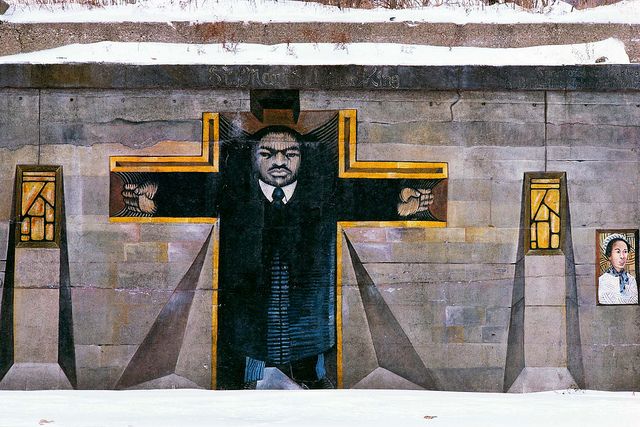
South Side Chicago, 1980. Mural by B. Walker. Credit: Camilo Vergara
It is ironic that given King’s lifelong struggle against segregation and poverty, his name and likeness have become one of the defining visual elements of the American ghetto, a place he worked his whole life to abolish. His dream of justice and equality for all seems as distant from the seemingly permanent ghettos of today as they were when he was alive.
I value the street images of King in all their earnest misrepresentations because of the hopes they embody. But most murals and street portraits are ephemeral. Paint fades, businesses change hands, art is defaced and neighborhood demographics shift. If folk art museums collect murals at all, typically these are commissioned works by professional artists, and such museums seldom collect photographs.
My pictures are often the only lasting record of these public works of art. As I find and photograph them during my urban explorations, I take satisfaction in creating a permanent record of a historically important subject that is often overlooked and, as the urban fabric changes, will inevitably disappear.
Camilo Vergara is a Chilean-born photographer now living in New York. His books include American Ruins and How the Other Half Worships.

